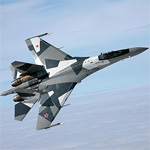Russia goes on arms spending spree

Russia has unveiled the biggest rearmament program since the fall of the Soviet Union, saying that it intends to buy 600 planes, 100 ships and 1,000 helicopters within the next decade.
The ambitious overhaul will cost the equivalent of $644 billion and comes at a time when other countries such as Britain are cutting their defence spending to try to balance their national budgets.
But with oil prices rising, Russia, the world’s biggest energy exporter, feels confident it can afford to upgrade its dilapidated Soviet-era military and believes it urgently needs to do so to confirm its self-proclaimed status as a leading world power.
Vladimir Popovkin, Russia’s deputy defence minister, said the rearmament program would be sweeping.
“The main task is the modernization of the armed forces,” he said. “Nineteen trillion roubles ($644 billion) will be allocated for this. We are not interested in purchasing any foreign weapons or military equipment.”
Vladimir Putin, the prime minister, has joked that he is frightened to even imagine how much the Kremlin is about to spend on arms. Alexei Kudrin, the finance minister, has said that defence spending will account for 1.5 per cent of gross domestic product, up from 0.5 per cent now.
Mr Popovkin said the shopping spree would reshape the Russian navy, giving it 35 new corvettes, 15 new frigates and 20 new submarines, eight of which would be nuclear-powered and armed.
In total, he estimated that the navy, which is badly trailing the U.S. navy in terms of modern ships, would take delivery of 100 vessels before 2020.
Despite his claim that Russia would not need to buy foreign military hardware, two of the new vessels will be French-built Mistral class helicopter carriers.
Russia would build a further two new Mistrals at its own shipyards, he added.
The sale by France is controversial among some of Russia’s neighbours such as the Baltic states and Georgia: the vessels can carry 16 helicopters and dozens of armoured vehicles, giving Russia the ability to land hundreds of troops quickly on foreign soil.
Russia’s air force, which performed inconsistently during the country’s brief and victorious war against Georgia in 2008, will also be refitted and be given 600 more planes and 1,000 helicopters before 2020. The planes will mostly be Sukhoi 34 and 35 fighters, and the helicopters will include Mi-8 gunships and the bigger Mi-26 heavy lift cargo craft.
Russia’s fearsome TU-160 strategic nuclear bombers, which have begun to probe the limits of Britain’s airspace in recent years, will also be modernized.
Much of the spending will be channelled into strategic missile forces with several hundred mobile S-400 and S-500 defence missile systems on order and a new intercontinental ballistic missile, capable of carrying 10 nuclear warheads, in development.